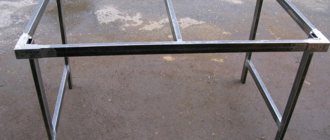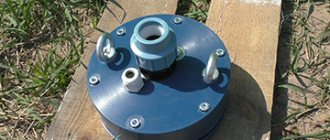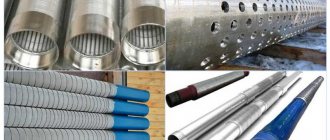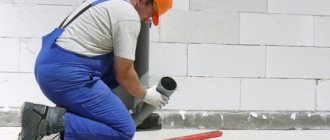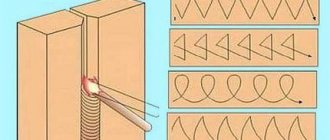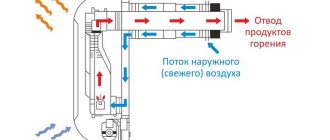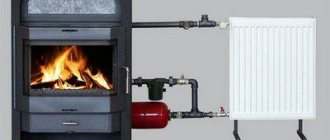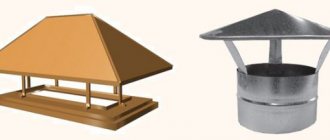Classification of caissons
A caisson is a sealed container designed to protect the wellhead from frost, precipitation and other negative phenomena. Its shape can be varied, but it is sufficient for a person to go down inside to service the equipment. A caisson for a well can be made of several types of materials:
Diagram of the caisson device.
- Plastic is the most convenient and practical option that has the best cost. The plastic design is lightweight, its installation is simple and quick, and does not require special experience. The rigidity in this case is not too high, although this can be compensated for by pouring a concrete ring along the contour.
- A caisson for a well made of concrete is also practical and durable, but its installation is complex and requires certain knowledge when planning. After installation, it is necessary to ensure excellent thermal and waterproofing.
- Brick models are of the highest quality, but they are practically impossible to implement with your own hands. An experienced specialist is required, as installation is complex.
- A container made of metal is extremely strong, durable, and has excellent performance properties. The metal is susceptible to corrosion, so waterproofing work is necessary. But the strength and ability to withstand loads of this design are high.
Content
If this is a dacha designed only for summer living, then a lightweight summer version is a completely acceptable option, when the well practically has only a head above the mouth and is often not even equipped with a water supply.
If the house is intended for year-round use, then the low temperature season has to be taken into account. To ensure uninterrupted water supply at this time, a winter option is installed, which includes a caisson, a pit or a separate room built above the wellhead.
But all of the above work is very costly and time-consuming. All constructed facilities require periodic maintenance.
well adapter
An alternative to the above technical solutions that ensure year-round uninterrupted water supply to the house is to install a well without a caisson using an adapter. The specified technical solution involves placing all water treatment and supply equipment in the house itself, in a specially designated room in which positive temperatures are maintained. Most often, such a room is a boiler room. And in the well itself, only a special device is mounted - a well adapter, the design of which is very simple. It provides a sealed outlet from the outlet casing pipe, through which the water supplied by the deep-well pump enters the water supply system laid to the house.
Types of homemade caissons
A caisson for a well made of brick.
A master can make a special chamber to accommodate pumping equipment, automation, and a hydraulic accumulator from the following materials:
Reinforced concrete rings. This option is good only because with a high ground level and strong heaving of the soil, the camera will not budge due to its mass
But here it is important to take into account that the joints of the rings often have fistulas. The caisson will be periodically flooded
Installation of such a protective chamber will require significant costs: delivery of reinforced concrete elements, rental of special equipment for their installation. Monolithic concrete pouring. Considered more durable than ring construction. In addition, although the work is labor-intensive, even one master can do it. With proper reinforcement, the final concrete caisson will be strong, airtight, and durable. More often, such a chamber is made square due to the peculiarities of the formwork installation. Just like under reinforced concrete rings, under concrete you need a solid foundation. Metal. Such a chamber is being installed less and less often, since steel is prone to corrosion, and therefore to destruction over time. To avoid this, when installing a metal caisson, you will have to additionally treat the material with special paints. In addition, the quality of the welds is not always ideal, which leads to the formation of fistulas and further flooding of the chamber.
Brick. The best option is a caisson if the master wants to install the camera himself. This type of construction is especially relevant if there are remains of blocks from a built cottage on the site. The brick caisson is durable and reliable. The main thing is to treat its outer walls with bitumen mastic for complete sealing. Polymer. Here you can use a large barrel, or buy a plastic caisson with stiffeners. Working with polymer tanks is easier than with others. In addition, plastic caissons last for 50 years or more.
Useful tips
- When installing a metal and plastic caisson, it is best to install the tank on pre-laid wooden beams, which, after successfully aligning the sleeve and casing pipe, are carefully removed.
- Installation of plastic products is carried out in exactly the same way as installation of metal caissons. Even if a plastic container is equipped with stiffening ribs, to strengthen the structure, a lathing is installed around the tank, which is filled with concrete. Backfilling with earth is done after the solution has completely set.
- Metal caissons require periodic renewal of the anti-corrosion coating.
- Arranging a pit in the spring will allow you to most accurately assess the condition of the bottom of the pit, after which a decision is made on the need to concrete the floor of the pit.
- When constructing a caisson made of monolithic reinforced concrete, the solution poured into the formwork is compacted with a vibrating tool or bayonet to remove air cavities.
- Since each welding seam of a metal caisson is a potential source of corrosion, they try to reduce the number of such joints to a minimum.
Despite the fact that building a caisson for a well is quite a troublesome task, independently manufacturing and arranging a protective structure will bring bonuses to the owner in the form of significant cost savings and pleasure from the work done with your own hands. And most importantly, the well and pumping equipment will no longer be afraid of any frost!
Stages of installing caissons with your own hands
Installation of a monolithic concrete caisson
A monolithic concrete tank is poured as follows:
- The formwork is installed on the prepared base, leaving 20-30 cm from the walls of the pit. You can remove the frame from the boards gradually (30 cm at a time) or immediately to the entire height.
- Reinforcing mesh is installed in the formwork.
- Prepare a solution from cement, sand and crushed stone in a ratio of 1:3:5, respectively. Bulk mixtures are diluted with water until a mixture of creamy, thick consistency is obtained.
- The prepared solution is poured into the formwork in portions and carefully tamped with a metal rod to expel any remaining air.
- As soon as the tank has completely hardened, the formwork is removed and, using a hammer drill, holes are made in the walls for cables and water mains. All technical gaps are sealed with cement-sand mortar.
- The outer walls of the finished caisson are coated with bitumen mastic.
The top of the chamber can be equipped with a wooden panel covered with roofing felt, or a monolithic slab can be poured by first installing wooden formwork from durable boards
It is important to leave a hole in the slab for the hatch
Caisson made of reinforced concrete rings
Since it is difficult to make a caisson for a well from concrete rings with your own hands, you will need the help of special equipment. Before installation, elements must be treated on both sides with bitumen mastic. After it dries, the rings are lowered one by one into the pit onto a pre-prepared base. It is advisable to coat all joints with polyurethane foam and, after it has dried, go over it again with mastic.
Using a hammer drill, technical side holes are made and the gaps are sealed.
The top of the ring caisson can be made of a concrete slab with a hatch or simply a welded metal shield.
Brick caisson
Taking into account the fact that the bottom of the pit has already been prepared (there is a concrete platform), strips of roofing material should be laid along the perimeter of the future masonry. Only after this do they begin laying. You need to lay the brick from the corner, moving towards the opposite one from one side and the other. The thickness of the mortar between the blocks is 1-1.5 cm
It is important to install metal sleeves where water pipes and cables are expected to be located. Then the walls of the caisson are driven to the required level
As soon as the chamber is completely dry, it is plastered and coated with bitumen mastic on the outside and inside. After the waterproofing has dried, the chamber is backfilled.
Polymer caisson
Plastic caisson with stiffeners
You can make a caisson for a well from a plastic barrel or buy a ready-made durable structure with stiffeners. The second option is preferable, since the tank can withstand the pressure of heaving soil.
Often it is permissible not to make a strong concrete foundation for the installation of a polymer tank. A sand bedding 10-15 cm thick is sufficient.
Polymer caisson installation technology:
- The camera is installed on wooden beams, having previously formed a technical hole in the bottom for the casing.
- Carefully place the caisson on the pipe and lower it down.
- It is advisable to immediately make additional holes on the surface for the outlet of pipes and cables.
- The backfill of the polymer chamber is made from a sand-cement mixture. It is slightly moistened and compacted well in layers.
- It is better to place equipment in a plastic caisson 10 cm from the walls of the tank.
General requirements ↑
In any case, you need a pit 2 meters deep or a little deeper (for concrete you need a cushion). It is dug around the well casing. The size of the pit should be larger than the future caisson by 20–25 cm on each side if the work is carried out using machinery (so that the structure does not have to be installed with force and the installation of pipes is not complicated). The gap between the caisson and the walls of the pit is filled with soil. In the case of installing a caisson yourself or building it yourself, the pit is made even wider for the sake of convenience.
A cushion of sand and crushed stone is placed at the bottom of the pit. It is then filled with concrete with preliminary double reinforcement. The reinforcing mesh is assembled using knitting wire. Step - 20 cm. The caisson is installed on a concrete slab.
The casing pipe is buried (simply cut).
When constructing a well with a caisson, it is necessary to take care of the waterproofing of the structure. Plastic ones are not subject to corrosion. In most cases, metal ones are sold already processed. Self-made caissons are insulated before installation - the outer walls are treated with bitumen mastic. If you purchase an untreated structure, the scheme is the same - apply mastic to the external walls (sometimes to the internal ones).
The waterproofing layer must be uniform and continuous, without layers or smudges. According to building rules and regulations, buried structures must be processed in several layers. Allow each layer to dry. Bitumen mastic can be replaced with another material (cement waterproofing), but it is necessary to work strictly following the instructions included with the product.
The caisson must be insulated from the inside. The temptation to cover it with insulation on top is great, but experts say that in this case the adhesion to the ground is insufficient, and it is difficult to guarantee the immobility of the structure, and this immobility is necessary, since the connections are airtight, and the crawling caisson drags the casing along with it. They are insulated with various materials, including sprayed ones - most often polystyrene foam, polyurethane foam, and extruded polystyrene foam are used.
Preparatory work
The initial stage when installing any caisson is preparing a pit for it and laying the foundation. A hole is dug according to the dimensions of the future chamber plus 20-30 cm on all sides, including the bottom. As a result, the neck of the caisson should rise 20 cm above ground level. This makes it possible to prevent precipitation from entering the protective structure.
The bottom of the pit is well compacted. Sprinkle a 10 cm layer of sand on the cushion and compact it well. If the installation of concrete, brick or caisson made of reinforced concrete rings is planned, a cement platform with a thickness of 15-20 cm must be made. It is better to reinforce it. Once the base is ready, you can begin constructing the caisson.
Arrangement of the CDS
Equipped with the following equipment:
- Pump: submersible or surface pump.
- Filtration system.
- Hydraulic accumulator.
- Automation block.
- Shut-off valves.
- Pipeline.
- Check valve.
- Measuring instruments (pressure gauge, etc.).
Installation must be carried out in accordance with certain requirements:
- Depth not less than 2000 mm.
- The casing pipe should be in the center of the pit.
- When constructing a container made of concrete, a base of crushed stone and sand is built.
- The walls of a concrete or brick KDS must be waterproofed.
- The pit should have dimensions 300 mm larger on all sides around the perimeter.
- When purchasing a PVC structure, waterproofing work is not required.
- From the inside, the structure must be insulated with heat-insulating material.
- Subject to the presence of groundwater, the chamber is mounted ready-made. All actions to prevent moisture penetration occur on the surface.
Types of caissons
For the manufacture of equipment, a material is used that will provide sufficient thermal insulation and the required sealing that must be inside.
There are the following types of caissons:
- Made of plastic. It provides a good seal. The material is lightweight, so the device is easy to transport and install. But the structure itself is not rigid enough, and to prevent it from floating up, the chamber is filled with concrete along its contour.
- Made of metal. The most commonly used is steel. This material is durable and will last a long time. If the chamber is made correctly, it will provide a seal and will not float. But the material is susceptible to corrosion, so waterproofing is required.
- Made of concrete. The container is durable, but does not withstand moisture. Therefore, as is the case with the installation of metal structures, waterproofing is required. The installation is heavy, so transporting and installing the structure is problematic.
- Made of brick. Thermal insulation characteristics are higher compared to other materials; additional insulation is not required. Only a person who is well versed can install the camera. This option is durable and economically beneficial.
- Made from polymer sand. The system itself is inexpensive, sealed and durable. In addition, it is easy to use.
All types have both advantages and disadvantages. Before choosing a structure, you need to think about what the owner wants to achieve during installation, the speed of work, the cost of the caisson, durability of operation, etc.
Plastic, metal or concrete? Why choose plastic
Let's try to conduct a comparative analysis of three types of caissons for wells that you can install near your home.
| Parameters for comparison | Plastic | Metal | Concrete |
| Tightness | Completely sealed due to the absence of seams, no need for waterproofing | Has welding points. Seams, even those protected by coating, begin to leak over time. With seasonal soil movements, the seams may burst under soil pressure. | It requires treatment with waterproofing compounds, as it does not tolerate constant humidity. |
| Features of installing a caisson for a well | Lightweight tank does not require special equipment for installation | Metal caissons for wells made of high-quality thick steel weigh a lot, so they will have to be installed using a lifting mechanism. | If concrete rings are used to construct a caisson, you cannot do without special equipment. Filling the tank over the formwork can also be done manually. |
| Strength | Plastic caissons are resistant to chemical attack, but can suffer serious damage from careless installation, soil deformation, or improper cleaning. To increase structural strength, manufacturers equip tanks with additional stiffeners. | Steel is a durable material that is not afraid of deforming soil movements. At the same time, it is quite flexible, and, unlike plastic, does not burst under stress. A steel caisson can be deformed, but still remain sealed if the welds are well made. | Reinforced concrete structures are highly durable. They are not afraid of any ground movements. High-quality concrete is not afraid of soil pressure and rough cleaning manipulations. |
| Resistant to corrosion and stains | Polymer materials are immune to rust, fungi, bacteria, and chemical attack. | Steel caissons are most susceptible to rust. To extend their service life, containers are treated with protective compounds. If necessary, the protective composition can be renewed from the inside, but to paint the steel caisson from the outside, it would have to be removed with the risk of deformation or damage, so no one does this. | Fungi sprout and bacteria multiply on the concrete surface. Such a tank will have to be periodically cleaned with special compounds, but the spores can penetrate so deeply that no amount of cleaning will help. Concrete absorbs moisture and it destroys it over time. |
| Thermal insulation | Plastic has low thermal conductivity, so there is no need for additional insulation or heating of the tanks. Only in areas north of St. Petersburg does it make sense to additionally insulate the container from the outside, especially the lid. | Metal containers need insulation. For this purpose, you can use any construction insulation that is installed during installation of the structure. | Concrete does not hold heat well, so such tanks need insulation and heating in winter, even in the middle zone. |
| Floating | A lightweight plastic container will float under the influence of groundwater if it is not secured to a concrete base. | Heavy steel tanks generally do not float. However, they are also recommended to be fixed on a concrete base. | The heavy weight of the structure leaves it indifferent to this factor and the concrete well does not require additional reinforcement. |
| Price | The price of a plastic caisson is on average 20–35 thousand rubles, depending on the volume. | The price of a steel caisson depends on the thickness of the walls. Prices for a tank start from 40 thousand and above. | If you fill the pool with your own hands, it will cost you inexpensively, about 10-15 thousand. |
Convenient ladders are installed in large plastic caissons, so it is very convenient to use them as storage facilities
Types of materials for caisson construction
Before you begin installing a caisson for a well, you should select the material of construction, comparing the characteristics of various options.
- Plastic models are resistant to moisture, and their light weight makes installation easy. The disadvantage of the material is its relatively low strength. This can be dealt with by contour filling the container with concrete mortar.
- Concrete structures require some effort during installation. In addition, when making a caisson from concrete rings, you will need to pay for the services of special lifting equipment. At the same time, concrete caissons can be considered quite reliable and durable.
- You can make a caisson for a well from metal yourself. This material also has adequate strength and durability. However, taking into account the operating conditions during construction, it will be necessary to ensure the most reliable waterproofing of such a product to prevent corrosion and to carefully monitor the integrity of the protective layer during operation.
- Installation of a caisson on a well can be carried out using the bricklaying method. During manufacture, such structures will require a protective layer to ensure tightness to ensure reliability. Purchasing building material will require capital investment, but for the caisson you can use bricks left over after building a house or garage.
What is this
A caisson for a water supply well or septic tank on your own land plot is a sealed device with the following functions:
- creating a positive temperature inside the cavity to prevent water from freezing,
- protection of the volume from the ingress of groundwater and melt water,
- ensuring the optimal distance of the pump from the wellhead,
- concentration of water supply or treatment units in one place,
- preventing people, animals and insects from entering the closed area.
The concentration of all elements allows for compact inspection and maintenance work. Sealing the space increases service life, protects the pipeline, hydraulic accumulator, treatment tanks, and pump from defrosting.
The need for a caisson when constructing a well is to locate the pump as close as possible to the surface of the earth. This makes it easier to install and maintain large and massive units. But there is a risk of defrosting and failure, which is prevented by a closed insulated cavity.
Types of caissons
The main feature of a caisson is a closed cavity. It is located on a private plot, usually underground, due to space saving and rational use of the surface.
The design is made vertically. In a horizontal section the following is performed:
- Wood
(larch), - the caisson looks like a closed classic well for water. - Metal
- vertical pipe of large diameter (from 1 meter). To increase strength, corrugated products are used. - Concrete (reinforced concrete)
, - a common arrangement of a well (inspection, overflow, connecting, etc.)
The latter option replaced the wooden device due to its improved consumer qualities. An alternative to a concrete caisson is polymer products.
Construction of a caisson for a well
Wiring communications in a private house also requires the presence of a clean drinking water supply system. For proper installation of the plumbing system, several important points must be taken into account. Firstly, the water supply must either be located at a depth below the soil freezing level, or be equipped with an active heating system. Such a system is not cheap, so a caisson buried at a depth of about two meters is considered a cheaper, but no less effective way to organize the water supply.
Construction of a caisson for a well
A caisson is a sealed cylindrical or square container made of waterproof materials. It helps protect water from the well from mixing with groundwater and freezing in winter. In the harsh Russian winter, the caisson is additionally insulated using foamed polymer or polystyrene foam. The well casing pipe enters the caisson from below, and water supply pipes come out from the side.
The dimensions of the caisson in each individual case are calculated individually. There is no point in making a large caisson, since in this case you will simply waste extra building materials. Typically, a caisson is built with the expectation that it will be convenient for one person inside the caisson to carry out maintenance and repair work. For these purposes, as a rule, it is enough to make a caisson with a diameter of one meter and a height of about two meters. Such dimensions will be enough to freely place a pump, automation for its control, pressure gauges and filters inside the caisson and protect it from freezing.
Installation of a metal structure
When deciding which caisson to choose for a well, you must take into account that to install the metal version you will need a cast slab as a base and fastening with anchors. Before installing the camera box, it should be covered with waterproofing material and primed from the inside. These are mandatory measures even when using stainless steel. Insulation is also required.
The method of laying communications has a number of differences. The well casing is pulled through a sleeve welded hermetically to the bottom. For other inputs, there are welded bushings in the walls. Fittings are screwed into them and water supply lines are brought out, and a power cable is laid to the electric pump.
The installation sequence is usually as follows:
- A pit is dug under the caisson.
- A sand cushion is poured and a concrete slab is laid.
- The well casing is cut to size.
- A caisson is placed over the pit on the channels or beams and carefully positioned until the pipe and sleeve coincide.
- The caisson is finally placed in its place.
- Digging auxiliary trenches for laying pipes.
- All necessary communications are connected.
- Install insulation and waterproofing.
- The camera is covered with soil.
Required tools and materials
When constructing a caisson, the joints between the concrete rings must be carefully sealed.
If the master decides to install a monolithic concrete caisson, the following materials should be prepared:
- cement M-400 and higher;
- medium-fraction crushed stone (30 mm);
- river sand;
- reinforcing mesh or rods;
- bitumen mastic;
- boards for formwork.
To install a brick caisson, you should prepare:
- cement M-400 and higher;
- crushed stone (fraction 20-25 mm);
- river sand;
- brick blocks (the number of pieces is calculated based on the estimated width and height of the walls, divided by the width and height of one block);
- bitumen mastic.
Tools you will need:
- a concrete mixer or a special tray for preparing the solution manually;
- bayonet and shovel;
- tamping;
- roulette;
- hammer and nails;
- Master OK;
- mallet;
- buckets;
- building level;
- gas-burner.
For all other types of caisson (made of polymer or rings), you will need the containers themselves plus a shovel and a tamper.
How to make a caisson yourself
To make it yourself, you first need to decide on the material and system parameters.
Monolithic concrete structure
A square shape is suitable for the device; erecting formwork is also much easier.
First you need to decide on the size of the pit that is being dug for the structure. The length and width are standardly equal, so they can be calculated as follows: measure the size of the caisson from the inside, add the thickness of 2 walls (10 cm).
It is also necessary to calculate the depth of the pit, which should be 300-400 cm greater than the height of the chamber. If everything is calculated, the drainage layer can be installed at the bottom of the pit.
If further concreting of the base of the structure is not planned, then this procedure is chosen
But when it is necessary to fill the bottom with concrete, the height must be taken into account. In addition, the pit must be such that the surface of the structure’s cover is flush with the soil.
To have more space for a person when repairing the system, it is best to place the camera not in the middle in relation to the casing, but on the side. And the equipment will be conveniently placed.
Construction of a monolithic concrete caisson.
The work is carried out as follows:
- They start by digging a hole. At this point, you can immediately dig a trench for water pipes to the house. Then they begin to install drainage, which consists of 2 layers: sand (up to 10 cm high) and crushed stone (up to 15 cm). With such drainage, even if water gets inside the caisson, it will not remain inside, but will quickly go into the soil.
- Afterwards you need to arrange the formwork. Often the pit wall is used as the outer layer of formwork. The side of the pit must be covered with polyethylene to prevent water from seeping from the concrete into the soil. Afterwards you need to make a frame using reinforcement.
- Mix the concrete solution. Fill it in small parts, compacting it well using an electric vibrator. If there is no device, then you can use a pin, a thin pipe and weld the handles. This device is quickly lowered into the concrete and then slowly pulled out to get rid of air and water bubbles, thereby making the concrete denser.
- Afterwards, the structure must be dried, regularly spraying the surface with water to prevent the concrete from cracking. If it's hot, you can cover it with a damp cloth.
- After a week, the formwork can be removed. And after 4 weeks, install the equipment.
Caisson made of concrete rings
The well system of concrete rings provides the following:
- First, a pit is prepared. The calculations are the same as in the previous manufacturing method.
- Fill the bottom with concrete and drill a hole for the pipe.
- They take concrete rings, which are pre-coated with a special waterproofing compound. Let it dry.
- Afterwards, each ring is lowered inside the pit, while connecting the joints using a bonding mixture. The seams are foaming.
- There may be voids around the structure that need to be filled.
A caisson for a well is made of concrete rings.
Budget brick camera
Construction of a brick caisson:
- First, a pit is dug, a strip foundation and a trench are installed at the bottom, which is filled with sand and compacted.
- It is necessary to lay waterproofing (for example, roofing felt) on the foundation.
- Brick laying begins from the corner, making sure to fill the seams with a special mortar.
- After bringing the masonry to the desired height, allow it to dry and plaster it.
pros
This will help determine which caisson is best to build.
| Advantages | ||
| Varieties | pros | |
| Plastic |
| |
| Reinforced concrete |
| |
| Concrete rings |
| |
| Brick |
| |
| Metal |
| |

